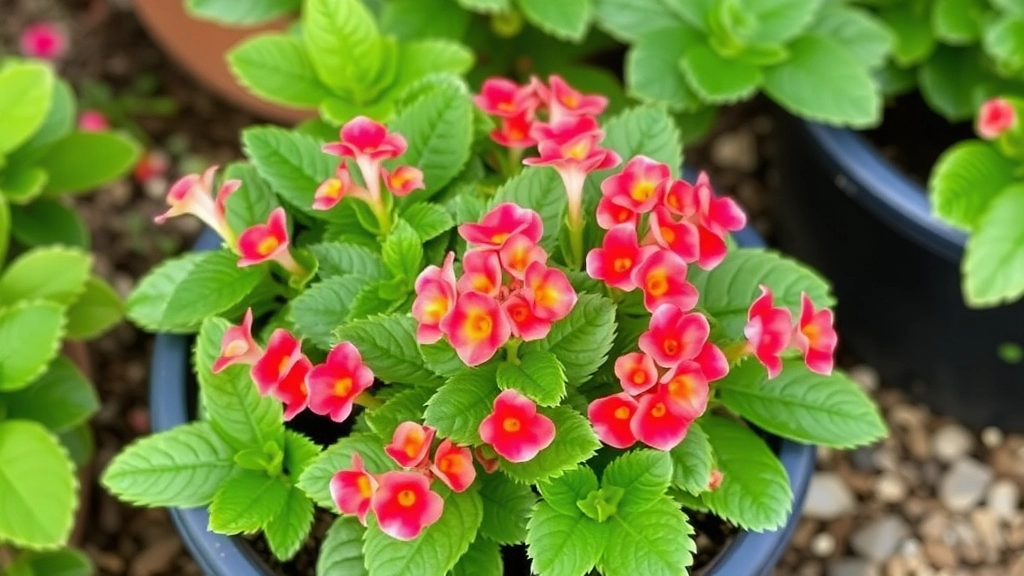How Often to Water Kalanchoe
Ever wondered “how often to water Kalanchoe”? You’re not alone. As a succulent lover, I’ve learned that Kalanchoe plants thrive on a careful balance of hydration. Too much water, and you risk root rot; too little, and the leaves start to droop. So, what’s the sweet spot?
Generally, watering your Kalanchoe every two to three weeks is ideal. Let the soil dry out completely between watering sessions. This routine mimics their natural habitat and keeps them healthy. Remember, it’s better to underwater than overwater. Stick to this schedule, and your Kalanchoe will flourish!
Understanding Kalanchoe’s Watering Needs
Have you ever wondered why your Kalanchoe seems to thrive one week and struggle the next?
Understanding Kalanchoe’s watering needs is crucial for maintaining a healthy plant.
Kalanchoe, a popular succulent, has specific requirements when it comes to watering.
Factors Affecting Watering Frequency
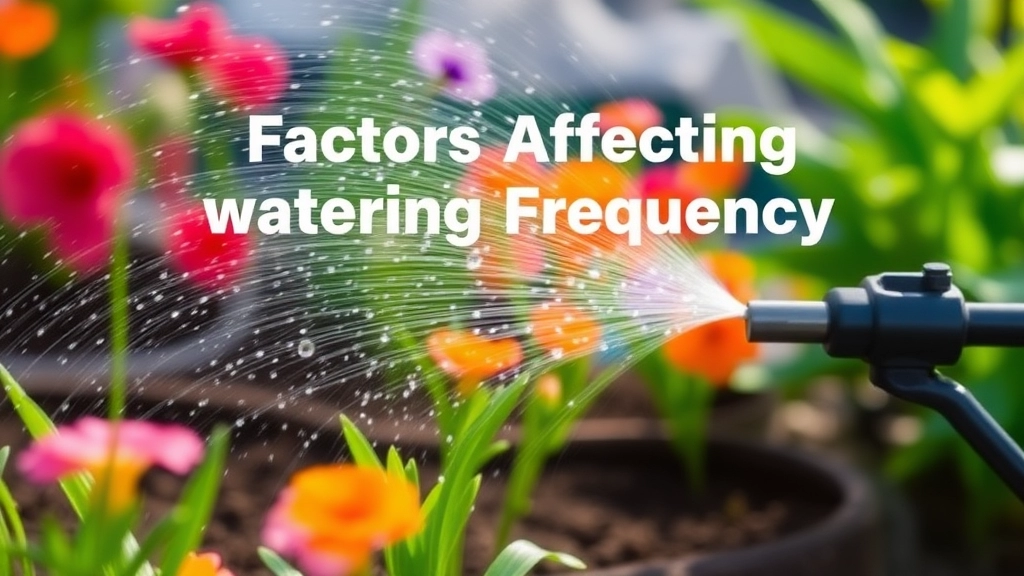
So, you’re wondering why your Kalanchoe might need a different watering routine compared to other plants?
There are a few key factors that can really influence how often you should be watering your Kalanchoe. Let’s break it down:
1. Climate and Environment
- Temperature: Warmer temperatures mean your plant will use water faster. In cooler months, it slows down.
- Humidity: If you live in a humid area, your Kalanchoe won’t need as much water. Conversely, in dry conditions, you might need to water more frequently.
2. Pot Size and Type
- Size: A larger pot holds more soil, which retains moisture longer. Smaller pots dry out quickly.
- Material: Terracotta pots are porous and let moisture escape, while plastic pots retain water. Choose wisely!
3. Soil Type
- Well-draining Soil: If your soil drains well, you’ll need to water less often. Heavy soils can retain too much moisture, leading to root rot.
- Mix: Adding sand or perlite can improve drainage.
4. Light Exposure
- Bright Light: If your Kalanchoe is basking in bright, direct light, it’s likely to dry out quicker.
- Low Light: In shadier spots, it will need less frequent watering.
5. Growth Stage
- Active Growth: During the growing season (spring and summer), your plant will need more water.
- Dormancy: In the fall and winter, it’s resting and requires less.
Signs Your Kalanchoe Needs Water
Recognising when your Kalanchoe is thirsty can be a game-changer for its health and vitality.
Best Time of Day to Water Kalanchoe
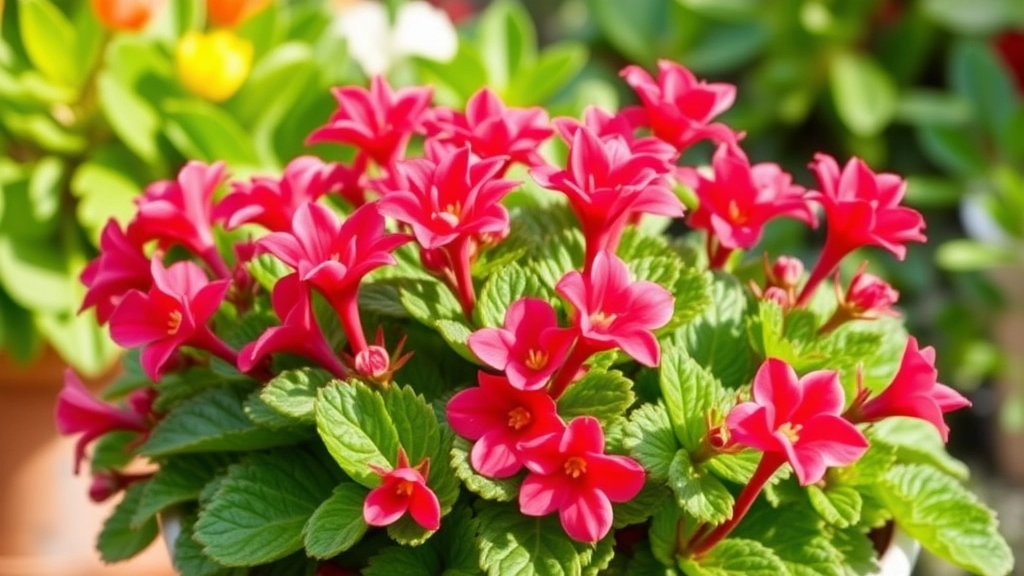
When it comes to watering Kalanchoe, timing can significantly influence the health of your plant. You might be wondering, “Is there a specific time that’s best for watering my Kalanchoe?”
Morning Watering: The Ideal Choice
Watering your Kalanchoe in the morning is generally the best practice. Here’s why:
- Temperature Regulation: Morning temperatures are cooler, which helps prevent rapid evaporation of water.
- Hydration Before Heat: Watering in the morning ensures your plant is well-hydrated before the heat of the day sets in.
- Disease Prevention: Early watering allows the leaves to dry out during the day, reducing the risk of fungal diseases.
Evening Watering: A Cautionary Approach
While some may consider watering in the evening, it’s not always advisable:
- Humidity Issues: Watering late can leave moisture on the leaves overnight, increasing humidity and the risk of rot.
- Overnight Stress: Plants may struggle to absorb water during cooler night temperatures.
Key Takeaways:
- Best Time: Water in the morning for optimal results.
- Avoid Evening: Try to steer clear of late watering to prevent moisture-related issues.
Watering Kalanchoe in Different Seasons
As we explore the watering needs of Kalanchoe, it’s essential to consider how seasonal changes impact these requirements. Each season brings its own set of challenges and opportunities for your beloved plant.
Spring: Awakening Growth
In spring, Kalanchoe enters its active growth phase.
- Watering Frequency: Increase your watering routine, allowing the soil to dry out slightly between sessions.
- Signs of Need: Look for new growth and vibrant leaves as indicators of health.
Summer: Peak Care
Summer brings warmth and sunlight, which can accelerate evaporation.
- Watering Tips:
- Check the soil moisture more frequently.
- Water early in the morning to prevent evaporation.
- Common Issues: Be cautious of overwatering, as higher temperatures can lead to rapid soil drying.
Autumn: Preparing for Dormancy
As temperatures drop in autumn, Kalanchoe begins to slow its growth.
- Watering Adjustments: Reduce the frequency of watering.
- Observation: Monitor for signs of wilting or drooping leaves, which may indicate a need for water.
Winter: Dormant Phase
In winter, Kalanchoe enters a dormant stage, requiring minimal care.
Indoor vs. Outdoor Watering Practices
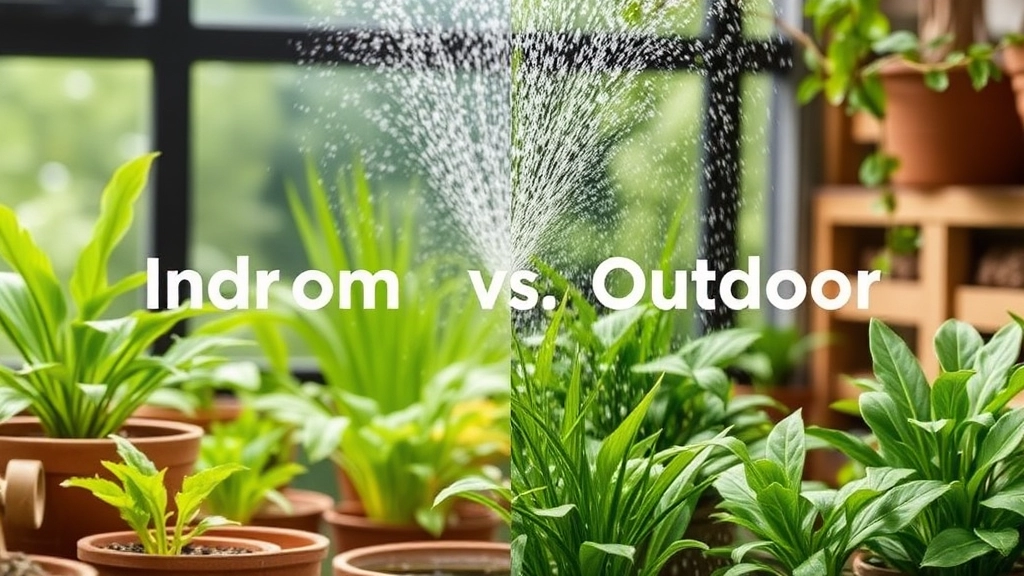
So, you’ve got your Kalanchoe thriving, and now you’re wondering if its watering needs change based on where it’s living—indoor or outdoor.
Indoor Watering Practices:
When your Kalanchoe is inside, it’s often in a more controlled environment. Here are some key points to consider:
- Humidity Levels: Indoor air can be drier, especially in winter. You might need to water a bit more frequently.
- Light Exposure: If it’s near a sunny window, the soil might dry out faster. Keep an eye on it!
- Pot Type: Make sure your pot has good drainage. No one likes sitting in soggy soil.
Outdoor Watering Practices:
Now, if your Kalanchoe is basking in the sun outside, things change a bit:
- Weather Conditions: Rain can alter your watering schedule. If it’s been rainy, you might skip a week!
- Temperature Fluctuations: Hot weather can dry out the soil quickly. You might need to water more often during a heatwave.
- Soil Type: Outdoor soil can vary. Sandy soils drain fast, while clay holds moisture. Adjust your watering accordingly.
Key Differences:
- Frequency: Indoor plants might need more regular checks, while outdoor plants can rely on nature a bit more.
- Environmental Factors: Indoors, you control the environment; outdoors, Mother Nature does.
Tips for Preventing Overwatering
Overwatering is one of the most common challenges faced by Kalanchoe owners.
Have you ever wondered why your Kalanchoe leaves are turning yellow or dropping off?
It could be due to excess moisture in the soil.
To maintain a healthy Kalanchoe, here are some practical tips to prevent overwatering:
- Check the Soil Moisture: Always feel the top inch of the soil before watering. If it feels dry, it’s time to water. If it’s still moist, wait a few days.
- Use Well-Draining Soil: Opt for a potting mix specifically designed for succulents. This type of soil allows excess water to drain away quickly.
- Choose the Right Pot: Ensure your pot has drainage holes. This prevents water from pooling at the bottom, which can lead to root rot.
- Water Sparingly: Kalanchoes thrive on neglect. Water less frequently, especially during the winter months when they enter dormancy.
- Observe the Plant: Pay attention to your Kalanchoe’s appearance. Healthy leaves should be firm and plump. If they become soft or mushy, it’s a sign of overwatering.
- Adjust for Environment: Consider your home’s humidity and temperature. In higher humidity, you may need to water less often.
If you notice your Kalanchoe leaves turning soft, it might be helpful to explore the causes and solutions for soft leaves. Additionally, for more comprehensive care tips, check out our best practices for indoor and outdoor care.
Using the Right Type of Water for Your Kalanchoe

So, you’ve got your Kalanchoe thriving, but have you thought about the water you’re using? It’s a common concern among plant lovers. Using the right type of water can make a world of difference for your plant’s health.
What Water Should You Use?
- Tap Water: Most people use tap water, and that’s totally fine! Just let it sit for a few hours to allow chlorine to evaporate.
- Rainwater: If you have access to it, rainwater is fantastic. It’s naturally soft and free from chemicals.
- Distilled Water: This is another great option. It’s pure and won’t add any unwanted minerals to your soil.
What to Avoid
- Hard Water: If your tap water is high in minerals, it could build up in the soil over time. This isn’t great for your Kalanchoe.
- Chlorinated Water: While letting it sit helps, if your water has a strong chlorine smell, it’s best to avoid it altogether.
Why Does It Matter?
The type of water you use can affect how well your Kalanchoe absorbs nutrients. Using the right water ensures your plant gets the best care possible.
For instance, I once had a friend who only used tap water straight from the tap. Over time, her Kalanchoe started to show signs of stress. Switching to rainwater made a huge difference!
Soil and Drainage Considerations
When it comes to watering your Kalanchoe, the type of soil and its drainage capabilities are crucial factors that can significantly impact the plant’s health.
Why Soil Matters
Using the right soil mix ensures that your Kalanchoe receives adequate moisture without becoming waterlogged. A well-draining soil helps prevent root rot, which is a common issue for these succulent plants.
Ideal Soil Composition for Kalanchoe
- Cactus Mix: This is often the best choice, as it is specifically designed for plants that thrive in dry conditions.
- Perlite or Pumice: Adding these materials can improve drainage and aeration.
- Organic Matter: A small amount of compost can provide essential nutrients without retaining too much moisture.
Importance of Drainage
Good drainage is essential for Kalanchoe care. Here’s why:
Common Watering Mistakes to Avoid
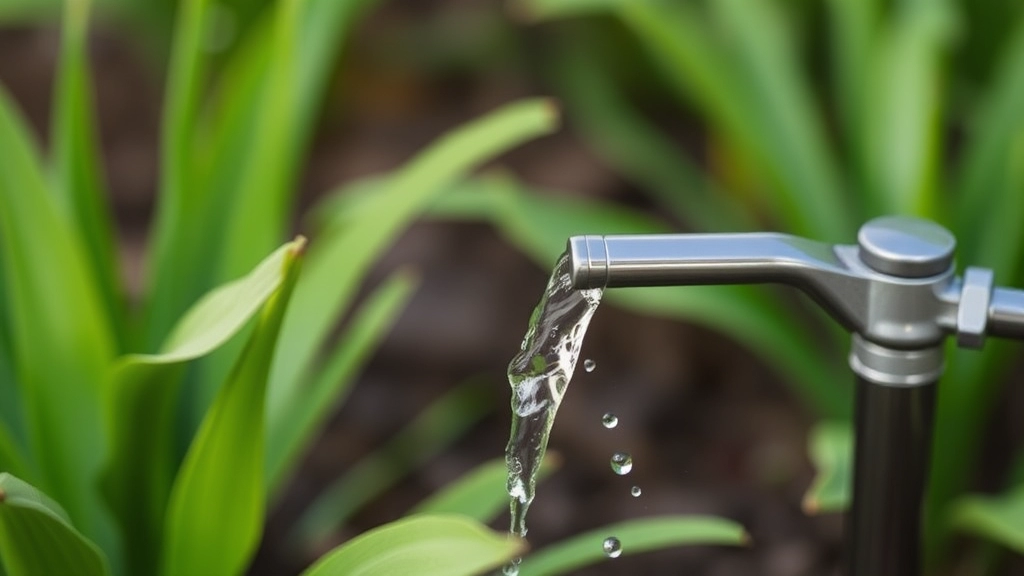
So, you’ve got your Kalanchoe all set up, but are you sure you’re not making some common watering mistakes?
1. Overwatering
This is the number one killer of Kalanchoe.
- How to spot it: Yellowing leaves, mushy stems, or a foul smell from the soil.
- Tip: Always let the soil dry out between waterings.
2. Underwatering
On the flip side, not giving your plant enough water can lead to stress.
- How to spot it: Shrivelling leaves or a droopy appearance.
- Tip: Check the soil moisture regularly.
3. Ignoring Drainage
Kalanchoes need well-draining soil.
- Tip: Use pots with drainage holes to prevent water from pooling.
4. Watering at the Wrong Time
Watering during the hottest part of the day can lead to evaporation.
- Tip: Early morning or late afternoon is ideal.
5. Using Tap Water
Chlorine and other chemicals in tap water can harm your plant.
- Tip: Let the water sit out for 24 hours before using it, or use filtered water.
6. Not Adjusting for Seasons
Your plant’s needs change with the seasons.
- Tip: In winter, reduce watering frequency as the plant goes dormant.
7. Relying on a Schedule
Watering on a strict schedule can lead to over or underwatering.
- Tip: Always check the soil moisture before watering.
Monitoring and Adjusting Your Kalanchoe Watering Routine
As we dive deeper into caring for your Kalanchoe, it’s crucial to understand how to monitor and adjust your watering routine effectively.
Why Monitoring Matters
Are you unsure if your Kalanchoe is getting the right amount of water? Over time, I’ve learned that consistent observation is key to maintaining healthy plants. Here’s what to keep an eye on:
- Soil Moisture: Check the top inch of soil. If it feels dry, it’s time to water.
- Leaf Condition: Yellowing leaves can indicate overwatering, while shrivelling leaves often mean your plant is thirsty.
- Growth Patterns: If your Kalanchoe isn’t growing or flowering as expected, it might be a sign of improper watering.
Adjusting Your Routine
Once you’ve monitored your plant, it’s time to make adjustments. Here’s a simple approach:
- Seasonal Changes: During the growing season (spring and summer), increase watering frequency. In contrast, reduce it in the dormant months (autumn and winter).
- Humidity Levels: If you live in a more humid environment, you might need to water less frequently. Conversely, in dry climates, your Kalanchoe may require more water.
- Container Size: Larger pots retain moisture longer. If you’ve recently repotted, adjust your watering schedule accordingly.
Keeping a Watering Journal
Consider keeping a watering journal. Document when you water, the weather conditions, and any changes in your plant’s appearance. This will help you identify patterns and refine your approach over time.
For more detailed guidance on ensuring your Kalanchoe thrives, check out our Ultimate Guide to Flowering Kalanchoe Care. Additionally, if your plant isn’t flowering as expected, you might find our article on Why Your Kalanchoe Isn’t Flowering particularly helpful.
FAQs on How Often to Water Kalanchoe
1. How often should I water my Kalanchoe?
The frequency of watering Kalanchoe depends on several factors such as climate, pot size, soil type, light exposure, and the plant’s growth stage. Generally, you should let the soil dry out between waterings.
2. What factors affect the watering frequency of Kalanchoe?
Key factors include climate and environment, pot size and type, soil type, light exposure, and the plant’s growth stage. Warmer temperatures, lower humidity, smaller pots, and well-draining soil typically require more frequent watering.
3. What is the best time of day to water Kalanchoe?
Watering in the morning is generally the best practice. It helps with temperature regulation, ensures hydration before the heat of the day, and reduces the risk of fungal diseases.
4. Can I water my Kalanchoe in the evening?
Evening watering is not advisable as it can leave moisture on the leaves overnight, increasing humidity and the risk of rot. Plants may also struggle to absorb water during cooler night temperatures.
5. How does indoor watering differ from outdoor watering for Kalanchoe?
Indoor Kalanchoes often need more frequent checks due to controlled environments with drier air and varying light exposure. Outdoor Kalanchoes rely more on natural conditions like rain and temperature fluctuations, which can affect the watering schedule.
6. What type of water is best for Kalanchoe?
Tap water is generally fine if left to sit for a few hours to evaporate chlorine. Rainwater and distilled water are excellent choices as they are free from chemicals and unwanted minerals.
7. What common watering mistakes should I avoid with Kalanchoe?
Common mistakes include overwatering, underwatering, ignoring drainage, watering at the wrong time, using tap water without letting it sit, not adjusting for seasons, and relying on a strict watering schedule. Always check soil moisture before watering.
8. How can I tell if my Kalanchoe is overwatered or underwatered?
Overwatered Kalanchoes often have yellowing leaves, mushy stems, or a foul smell from the soil. Underwatered plants may have shriveling leaves or a droopy appearance. Always let the soil dry out between waterings for best results.
9. Should I adjust watering frequency based on the season?
Yes, during the growing season (spring and summer), Kalanchoes need more water. In the fall and winter, when the plant is dormant, reduce the watering frequency.
10. Is it okay to use hard water for Kalanchoe?
Hard water can build up minerals in the soil over time, which isn’t ideal for Kalanchoe. If your tap water is high in minerals, consider using filtered or distilled water instead.
References
-
Gardening Know How: Kalanchoe Plant Care
-
The Spruce: Growing Kalanchoe Indoors
-
Houseplant 411: Kalanchoe – How to Grow and Care Tips
